Related Research Articles

Raleigh is the capital city of the U.S. state of North Carolina and the seat of Wake County. It is the second-most populous city in North Carolina, after Charlotte. Raleigh is the tenth-most populous city in the Southeast, the 41st-most populous city in the U.S., and the largest city of the Research Triangle metro area. Raleigh is known as the "City of Oaks" for its many oak trees, which line the streets in the heart of the city. The city covers a land area of 148.54 square miles (384.7 km2). The U.S. Census Bureau counted the city's population as 467,665 at the 2020 census. It is one of the fastest-growing cities in the United States. The city of Raleigh is named after Sir Walter Raleigh, who established the now-lost Roanoke Colony in present-day Dare County.
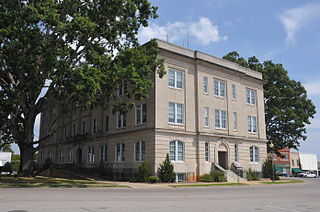
Moore County is a county located in the U.S. state of North Carolina. As of the 2020 census, its population was 99,727. Its county seat is Carthage and its largest community Pinehurst. It is a border county between the Piedmont and the Atlantic Coastal Plain.

Cumberland County is a county located in the U.S. state of North Carolina. As of the 2020 census, the population was 334,728, making it the fifth-most populous county in North Carolina. Its county seat is Fayetteville. Cumberland County is part of the Fayetteville, NC Metropolitan Statistical Area.

Tar Heel is a town located in Bladen County, North Carolina, United States. As of the 2010 census, the town population was 117.
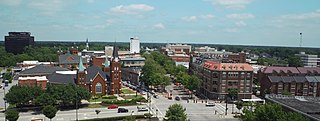
Fayetteville is a city in and the county seat of Cumberland County, North Carolina, United States. It is best known as the home of Fort Liberty, a major U.S. Army installation northwest of the city.
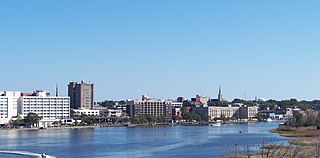
Wilmington is a port city in and the county seat of New Hanover County in coastal southeastern North Carolina, United States. With a population of 115,451 at the 2020 census, it is the eighth-most populous city in the state. Wilmington is the principal city of the Wilmington, NC Metropolitan Statistical Area, which includes New Hanover, Brunswick, and Pender counties. Its metropolitan statistical area had an estimated population of 467,337 in 2023.

Holly Springs is a town in Wake County, North Carolina, United States. As of the 2020 census, the town population was 41,239, a 67% increase from 2010.

High Point is a city in the Piedmont Triad region of the U.S. state of North Carolina. Most of the city is in Guilford County, with parts extending into Randolph, Davidson, and Forsyth counties. High Point is North Carolina's only city that extends into four counties. As of the 2020 census the city had a total population of 114,059. High Point is the ninth-most populous in North Carolina, the third-largest municipality in the Piedmont Triad, and the 259th-most populous city in the U.S.
Haywood is an unincorporated community in southeastern Chatham County, North Carolina, United States. It is part of the Moncure census-designated place. Along with several other unincorporated communities, it lies along the panhandle of Chatham County between Lee County and Wake County. Haywood lies at an elevation of 246 feet (75 m).
The Battle of Averasborough or the Battle of Averasboro, fought March 16, 1865, in Harnett and Cumberland counties, North Carolina, as part of the Carolinas Campaign of the American Civil War, was a prelude to the climactic Battle of Bentonville, which began three days later.

Fort Fisher was a Confederate fort during the American Civil War. It protected the vital trading routes of the port at Wilmington, North Carolina, from 1861 until its capture by the Union in 1865. The fort was located on one of Cape Fear River's two outlets to the Atlantic Ocean on what was then known as Federal Point or Confederate Point and today is known as Pleasure Island. The strength of Fort Fisher led to its being called the Southern Gibraltar and the "Malakoff Tower of the South". The battle of Fort Fisher was the most decisive battle of the Civil War fought in North Carolina.
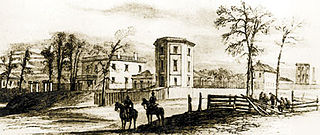
The Fayetteville Arsenal in Fayetteville, North Carolina was built in 1838 because during the War of 1812 the United States government realized that the existing distribution of weapons and ammunition factories was not adequate for the defense of the country. A program was begun to provide more Federal arsenals which would be distributed so that no area of the country would be too far away from an arms depot. Bladen County Representative James McKay introduced House Resolution #374 for inclusion of an arsenal at Fayetteville.

The North Carolina Maritime Museum is a system of regional museums within the North Carolina Museum of History, which in turn part of the North Carolina Department of Natural and Cultural Resources. There are several branches of the Maritime Museum located in Beaufort, Southport and Hatteras.

The Market House is a Market house and town hall in the center of Fayetteville, Cumberland County, North Carolina. It was built in 1838 on the site of the old state house and Town Hall which burned down in 1831. Fayetteville was the capital of North Carolina from 1789 to 1794.

Elliott Daingerfield (1859–1932) was an American artist who lived and worked in North Carolina. He is considered one of North Carolina's most prolific artists.

The Edgar Allan "E. A." Poe House is a historic home located at Fayetteville, Cumberland County, North Carolina.
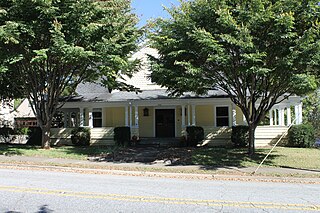
The Edgar Allan Poe House is a historic home located in Caldwell County at 506 Main Street NW in Lenoir, North Carolina.
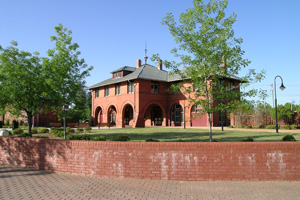
Cape Fear and Yadkin Valley Railway Passenger Depot is a historic train station located at 325 Franklin Street in Fayetteville, North Carolina. It was built in 1890 by the Cape Fear and Yadkin Valley Railway. It is a two-story brick passenger depot with a deep hip roof in the Romanesque Revival style. The seven bay by two bay building features a rounded brick arch arcade. It was listed on the National Register of Historic Places in 1983.
The following is a timeline of the history of the city of Fayetteville, North Carolina, USA.
References
- Photos of the museum and exhibits
- Fayetteville Arsenal - Waymarking
- ↑ http://www.fayettevillenc.net/sites/st_capefear2.htm Archived 2010-01-24 at the Wayback Machine Fayetteville, N.C.: Museum of the Cape Fear
- ↑ http://www.fayettevillenc.net/sites/st_capefear2.htm Archived 2010-01-24 at the Wayback Machine Fayetteville, N.C.: Museum of the Cape Fear
- ↑ "National Register Information System". National Register of Historic Places . National Park Service. July 9, 2010.